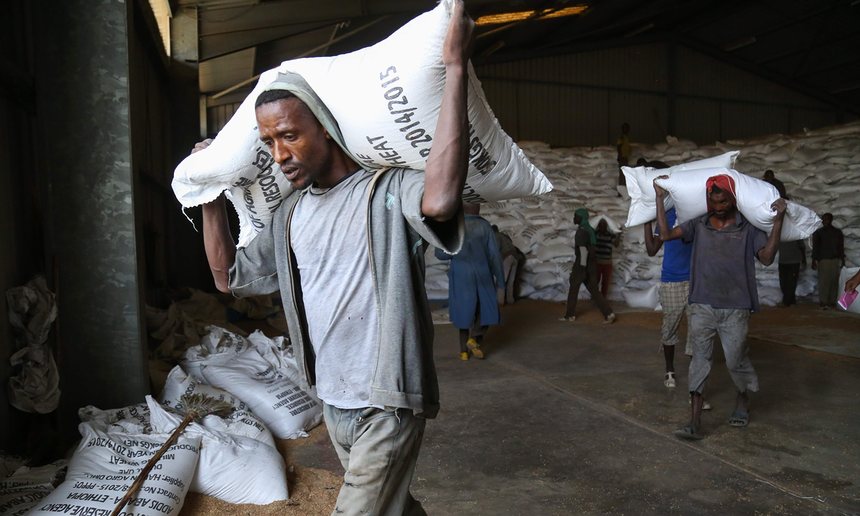PBS: Escaping Eritrea … [Read More...] about ካብ ውሽጢ ቤት ማእሰርታት ኤርትራ
Tate Munro and Lorenz Wild |
"We don't take sides; we help you see more sides."

Published:
PBS: Escaping Eritrea … [Read More...] about ካብ ውሽጢ ቤት ማእሰርታት ኤርትራ
Tate Munro and Lorenz Wild |
Importing emergency food rations on a large scale overrides local efforts to produce food and undermines the systems needed to withstand future crises
The current El Niño-driven drought in Ethiopia is the 15th in Kemal Umer’s lifetime. For Umer and his family, who live in the Afar region, life can be a constant struggle even in the best of times. The income they earn from raising livestock is barely enough to feed the family, and drought conditions make things worse. A single bad season could mean they won’t have enough to eat.

More than 83% of Ethiopians live in rural areas where many families are dependent on their own agricultural production, living harvest to harvest. But these areas are also vulnerable to droughts caused by climate change, economic instability and increasing competition over shrinking natural resources, such as pasture land and surface water.
Umer and other pastoralists have relied on coping mechanisms learned over many generations. When drought occurs, for example, people often simply migrate to less affected areas. But the population explosion in Ethiopia over the last 50 years – from 22.2 million to 95.5 million – along with a boom in commercial agriculture, has left migration routes and grazing and watering areas used in the dry season inaccessible.
For many families, there is nowhere left to move when disaster hits. The changing climate has forced people like Umer to skip meals or sell household assets when their incomes run low, leaving them exposed to poverty and chronic vulnerability.
Umer, like many Ethiopians, still struggles to feed his family of eight children, even though almost $5.4 bn in food aid and humanitarian assistance (pdf) has been donated to the country between 2000 and 2010.
Our experience in Ethiopia – and more than 40 other countries facing the world’s toughest challenges – shows that massive direct food aid programmes often fail. Direct food aid – importing emergency food rations on a large scale – overrides local efforts to produce and distribute food, and tends to damage local and national resilience rather than support it.
In Ethiopia, direct aid risks years of work spent building savings and credit services, new trading networks and markets for livestock, veterinary services and fodder. Today, these systems underpin Ethiopia’s tolerance to withstand droughts, as well as the capabilities of its people to bounce back once the worst days have passed.
On the positive side however, humanitarian and development aid has helped Ethiopia to make huge progress in agricultural production and economic self-sufficiency since its last major drought in 2011. The state has invested in infrastructure such as early warning systems to track the threat of famine, and strengthened social protection and market systems. The Ethiopian government has spent $381m since last summer to help those threatened by drought, and to prevent the type of emergency situation that results in large-scale international interventions.
As the fastest growing economy in the world, Ethiopia is now far more resilient to shocks like El Niño, and better positioned to meet its challenges with help from smart programmes such as USAid’s Feed the Future initiative. Through this initiative we are working with the Ethiopian government, its people and development partners – such as the African Alliance for Improved Food Processing – to help farmers increase the value of their sales. Following years of investment, Ethiopia can now leverage international funding, people and technical know-how to withstand the drought’s worst effects.
The global response to drought in Ethiopia must reinforce the country’s systems that already work, and food aid must be delivered only when and where it is absolutely necessary. To help Ethiopia maximise its long-term investments, while responding to the immediate effects of El Niño, NGOs and governments must all:
As part of Mercy Corps’ pastoralist areas resilience improvement through market expansion programme (Prime), we are working to help Umer’s family and community manage this drought and prepare for any others in the future. As part of this resilience planning, Umer’s community recently enclosed about 25 hectares of pastoral land, and Mercy Corps delivered training on taking better care of the land and collective farming.
The story of Umer’s community efforts has spread and now more than 10 neighbouring communities copy the practice. While Umer is optimistic about the new management of their communal natural resources, it remains to be seen whether the international community will continue to be called on to deliver emergency aid in Ethiopia – or if local NGOs, governments and the private sector with a permanent presence on the ground can carry on working with the government to end the cycle of drought forever.
Tate Munro is a regional resilience adviser and Lorenz Wild is a senior economic technical adviser for Mercy Corps.